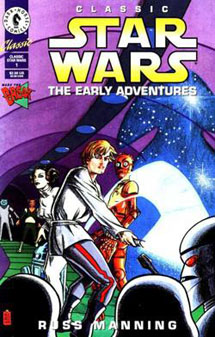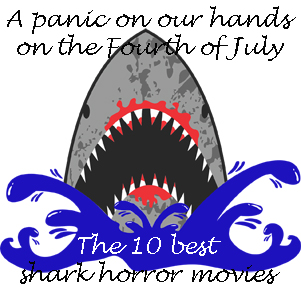After “Star Wars: A New Hope” came out in 1977, further adventures were told in three media: I recently wrote about the first novel, “Splinter of the Mind’s Eye,” and the first comic book issues from Marvel. But there’s also a less-talked-about third medium that was big back then but pretty much dead today: Syndicated newspaper comic strips. Alongside Garfield and Snoopy, fans could read about Luke, Han and Leia while eating their Raisin Bran.
Writer and artist Russ Manning — assisted by co-writers Hoberg, Don Christensen, Russ Helm and Steve Gerber — had the helm for all of the material up until, and a little bit after, the release of “The Empire Strikes Back,” and all the stories are set before “Empire.” (In fact, the Archie Goodwin strips that followed Manning’s were also set between Episodes IV and V.)
Manning’s work was collected by Dark Horse comics in “Classic Star Wars: The Early Adventures,”which ran for nine issues in 1994-95. Dark Horse had already published the Goodwin run in the 20-issue “Classic Star Wars,” so the company had practice with the rarely attempted process of adapting a strip into a book. For presentation purposes, this entailed coloring and retouching the art. For the sake of story flow, it meant taking out some panels (and, rarely, adding new ones by a guest artist), taking out some redundant dialog (and, rarely, adding new dialog). Also, some panels are cropped for the sake of flow and a nice page layout.
The first arc, “Gambler’s World,” covers three issues, and each of the next six arcs is one issue. They feel slightly longer than a Marvel issue, but they aren’t meatier; rather, they are more of a slog to get through. Although I don’t have the original strips, I feel like Dark Horse adapted these stories as well as they could; guest writer and artist Rick Hoberg even gives an ending to the last arc, “The Frozen World of Ota,” which was truncated due to Manning’s failing health. It’s quickly apparent why Dark Horse published Goodwin’s work first and only relented to publish these due to demand from curious fans (such as me, admittedly).
By no stretch of the imagination can these stories be called “good.” The yarns are simple, with many inexplicable character motivations, bizarre plot developments and a just plain misunderstanding of the “Star Wars” universe on Manning’s part. These stories are much more fun to talk about (and criticize) than they are to read. Here are a few observations:
- The villain of “Gambler’s World” is Blackhole, who will later pop up in the novel “Luke Skywalker and the Shadows of Mindor” (2008). Here, he appears randomly like a hologram, but without so much as an unlikely “Scooby Doo”-style hidden projector. Although the siphoning of gambling profits is a secret undertaking by the Empire, they’re pretty shoddy at secret-keeping: They disguise their stormtroopers by painting them black.
- Issue 4, “Tatooine Sojourn,” has one of Manning’s better plots. In Luke’s first return to his home planet (This timeline says Marvel No. 31 and “Star Wars 3-D” No. 1 take place later), he finds that there’s a new Imperial outpost in place because Tatooine has become a hotbed of rebellion. The plot actually makes sense, as entrepreneur Anduvil (who delivers goods to the Alliance) teams up with Luke to find out how the Empire is wiping out rebel-oriented settlements. A bizarre side effect of the disease in rebels is that their eyes turn into “windows” showing star maps of rebel bases.
- No. 5, “Princess Leia, Imperial Servant,” is similar to Marvel No. 30 in that Leia lands on an Imperial factory planet, but it’s a much shallower story, and the word “megonite” annoyingly appears on almost every panel. One fun fact is that Grand Moff Tarkin’s widow is the villain of the piece.
- No. 6, “The Second Kessel Run,” is the most apocryphal issue. Manning misunderstands spice, thinking it’s a foodstuff rather than a drug; he misunderstands Kessel, the prison planet the C-3PO dreads, choosing to portray it as a beautiful, lush world; and he misunderstands the Kessel Run (here, Han simply flies there fast, whereas in the “Han Solo Trilogy,” he cuts the DISTANCE — hence the measurement in parsecs, rather than speed — by skirting a black hole). Technically, those aren’t Manning’s fault, because the other interpretations came later, but he has no excuse for this one: Han delivers spice for Jabba, even though Jabba has a price on Han’s head at this point.
- No. 7, “Bring Me the Children,” is apparently an extreme take on the Empire’s opposition to private schools, as Darth Vader intends to shut one down by straight-up killing the teacher and all the students! (That’s one way to do it, but jeez, if word got out, even the Empire’s propaganda machine might have a tough time.)
- No. 8, “As Long As We Live …,” is potentially interesting, in that Darth Vader is hunting for Luke, but that angle stays in the background, and another father-son story instead moves to the fore.
- No. 9, “The Frozen World of Ota,” features Boba Fett, which makes it Manning’s best arc by default. It makes no sense that he flies a TIE fighter instead of the Slave I, but after that he’s more or less in character — going after the Empire’s bounty on a deserter. Fett runs into Han just by random chance and decides to try for that bounty, too.
Manning’s art is quite good, and the colorization is nice, but overall, his work is skippable for everyone except die-hard, super-curious “Star Wars” fans. We’re not talking “Holiday Special” bad, but really, this stuff is even a cut below the ridiculous Thomas-Chaykin work early in Marvel’s run. The format of three-panels-a-day storytelling is part of the problem, but Goodwin would go on to show that the format can yield superior yarns (his work will be the subject of a future post, of course).


